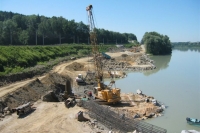Wels - Passau Railway Line,
Schärding - Wernstein Section
Client: Austrian Railways Infrastructure Construction AG
Development Period: 1999 bis 2010
In this project, a 4.0 km long section of the Wels - Passau railway line had to be adapted. A 1.1 km long section of the route had to be straightened with a maximum distance from the existing line of 40 m. The line had to be adjusted in order to meet the standards of a high-performance line. Lastly, the substructure had to be strengthened.
The project included the construction of the following: Extensive dam fills with ground improvement (partly reaching into the Inn River); An open excavation; Retaining structures; Two underpasses; Two overpasses.
All geological, geotechnical and hydrogeological consultation of this project was handled by BGG Consult. Initially, subsoil explorations (core drillings, dynamic probing, and test pits) were conducted. The test results were then used to compile a geotechnical expert's report that was necessary for the application of a building permit. BGG Consult also participated in the tender preparation.
Lastly, BGG Consult was responsible for the following: Calculations of the retaining structures; Dimensioning of building pit slopes; Determination of ground improvement measures; Supervision of the construction regarding all geotechnical matters.
Taxengraben Bridge:
In the section of the route that was straightened, a three-bay bridge with a total length of 120 m had to be constructed in the flood plain of the Inn River.
Due to the low bearing capacity of the upper soil, the high groundwater level, and the sustainable bedrock at a shallow depth, the object had to be constructed by utilizing bored piles (Ø 120 cm). BGG Consult determined the possible pile loads depending on the embedded length and the tectonic degradation of the crystalline.
Secured by dams, closed boxes of bored piles were constructed around the area of the foundation elements, which secured the building pit at the same time. Afterwards, the pile foundation grill (9.5 m below surface) was poured using underwater-concrete. Finally, the rising structure was built in a dry pit.
November 2010
